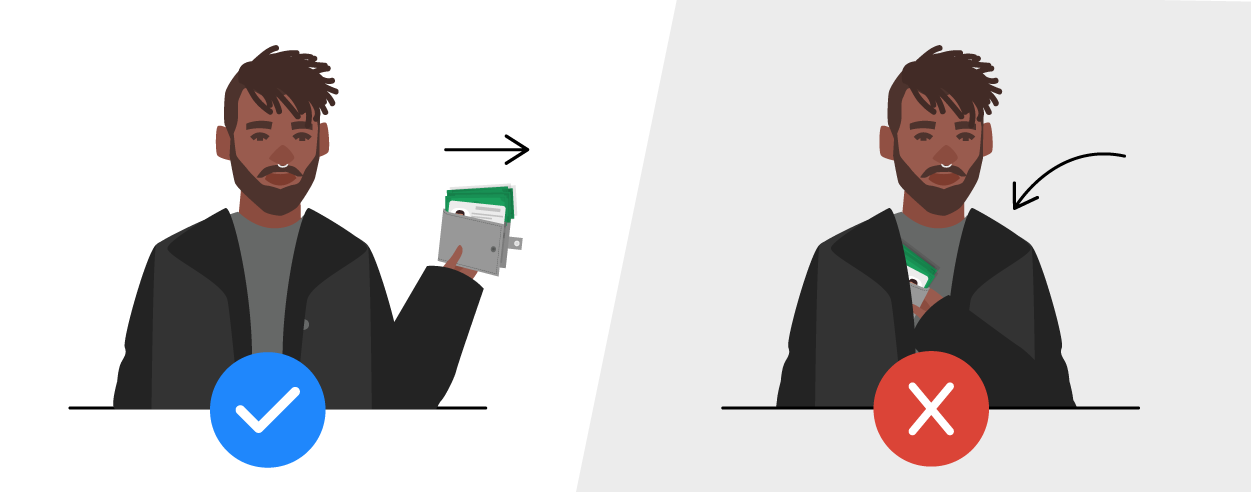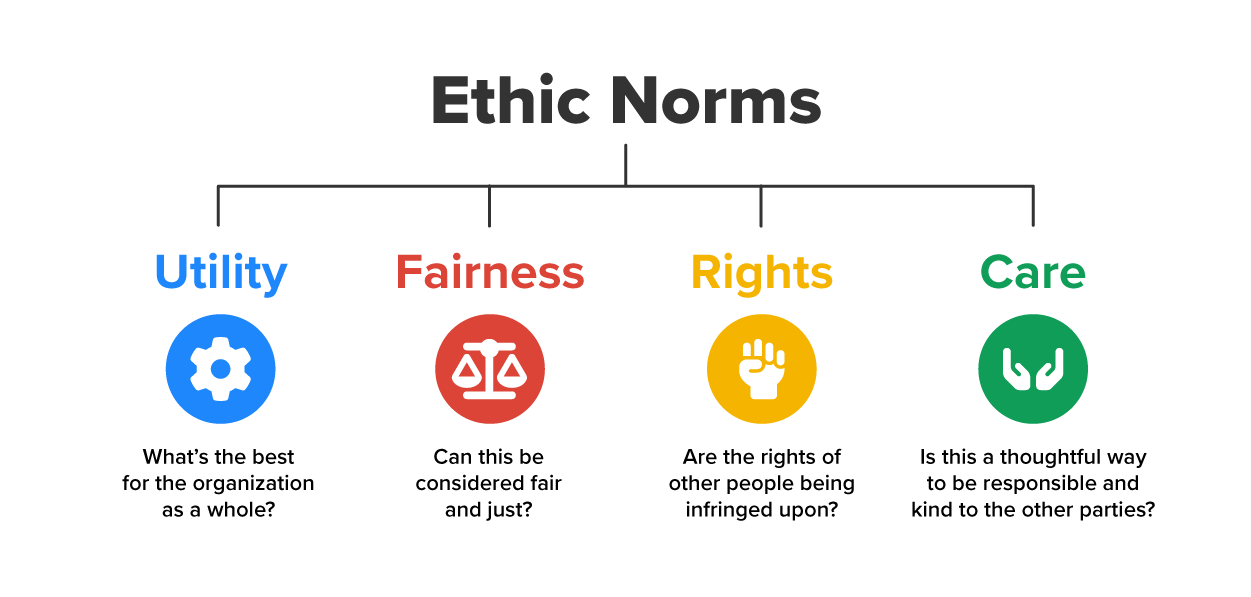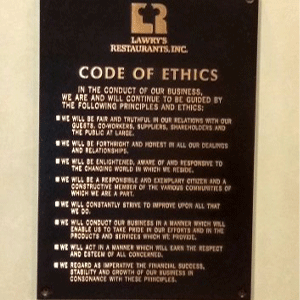Table of Contents |
Ethics refers to the principles of right and wrong and the morality of the choices involved. It’s also important to define what ethics is not. Ethics is not emotions, the role of law, or religion. It’s not necessarily the science or norms of a society. It’s also not simply following the law, because it’s perfectly possible to follow the law yet be an unethical person.
EXAMPLE

Characteristics of Ethics:
Business ethics is closely tied to what ethics is. It refers to the principles of right and wrong and the morality of the choices made within the business world. Essentially, what we’re doing is taking the principles or the definition of ethics and applying it in the business context. It encompasses all aspects of business behavior, covering both personal actions and organizational practices.
EXAMPLE
 Patagonia, an outdoor clothing company, is renowned for its business ethics and prioritization of environmental responsibility. As part of its business strategy, Patagonia donates 1% of sales to environmental groups, incorporates recycled materials into many products, encourages repair over replacement, and advocates for the protection of national monuments. This dedication to ethics has earned the company loyal customers and significantly reduced its environmental impact.
Patagonia, an outdoor clothing company, is renowned for its business ethics and prioritization of environmental responsibility. As part of its business strategy, Patagonia donates 1% of sales to environmental groups, incorporates recycled materials into many products, encourages repair over replacement, and advocates for the protection of national monuments. This dedication to ethics has earned the company loyal customers and significantly reduced its environmental impact.
Managerial ethics is, again, simply ethics. It refers to the principles of right and wrong and the morality of the choices made in the context of management. It explores the moral challenges and choices that managers encounter in organizations, including how they interact with employees, make key decisions, and balance the needs of various stakeholders.
EXAMPLE
Johnson & Johnson’s 1982 Tylenol crisis was a turning point. After seven people in Chicago died from cyanide-laced Tylenol, CEO James Burke took swift action. He recalled 31 million bottles nationwide, at a cost of over $100 million, and halted production and advertising. He also pioneered tamper-proof packaging, which became an industry standard, and offered free replacements for recalled products.Johnson & Johnson’s ethical response set a new benchmark for crisis management, ultimately strengthening consumer trust. The company’s approach was remarkably similar to Bud Light’s in 2023, when it faced a significant sales decline due to social media backlash.
Managerial decisions impact employee behavior. How you hire or fire, the wages you pay, or the working conditions at your business are all ethical decisions, and they can greatly impact employee attitudes and productivity.
IN CONTEXT: Lawful Versus EthicalBeing lawful means following the rules set by a legal system and authority, whereas ethical action is based on moral values or principles that may vary depending on personal standards, even when the law doesn’t require it.
When a multinational corporation sets up offshore accounts to lower their tax liability, some may see this as unethical, but it’s perfectly legal. On the other hand, if a nurse gives extra pain relief to help a patient, even if it’s against medical laws, it’s considered unlawful by the law, while others might view this action as compassionate and ethical.
Managerial ethics decisions can also impact behavior toward an organization. Do you have conflicts of interest or allow them? A conflict of interest is a circumstance in which a person’s or organization’s private interests could potentially interfere with their professional duties or decision-making. This conflict can lead to bias and compromise the integrity of decisions made in the business setting.
EXAMPLE
 If you have an employee working for you but who also works for a direct competitor, they will have a conflict of interest since they have an advantage in both places.
If you have an employee working for you but who also works for a direct competitor, they will have a conflict of interest since they have an advantage in both places.
Another aspect of business ethics that is important in maintaining trust with customers is confidentiality. Confidentiality is keeping private trusted data out of the hands of the public and other people who don’t need to see it. This might include personal information, such as credit card numbers or addresses. Giving this information out, or not protecting it appropriately, might be considered unethical.
Collusion is an attempt by businesses to conspire to the disservice of customers, businesses, or the general public. To explain collusion, we can look at price fixing, which refers to competitors working together to raise prices or manipulate the stock market to get more profit by charging more for their product.
EXAMPLE
RealPage, a real estate software company, is accused of illegal coordination of rent prices among landlords through its rent-setting algorithms. The lawsuit says that the software allows landlords to share information and set collective rents, which resulted in rent increases in eight states (Office of Public Affairs, 2024).Making ethical decisions involves several thoughtful methods and processes that help ensure fairness, integrity, and respect for others. Here are some different ways to understand ethical decisions:

In many situations, there may be no simple right or wrong answers. Yet, there are several questions you can ask yourself and a couple of self-tests you can do to help you make the right ethical decision. Click through to review each step:
Another approach to ethical decision-making is a formal process. The ethical decision-making process is a structured approach used to evaluate and choose among alternatives in a way that aligns with ethical principles and values. It typically involves the following steps:
Let’s look at how this ethical decision-making process might be used:
IN CONTEXT: Too Good to Be TrueSuppose a manager discovers that a top-performing employee has been falsifying sales numbers to earn bonuses.
- The first step is recognizing that the behavior is dishonest and violates company policy.
- Next, the manager gathers the facts by reviewing reports, confirming discrepancies, and consulting HR about company procedures.
- Then, they evaluate alternatives:
- Ignore the issue.
- Confront the employee privately.
- Report it formally.
- Considering ethical principles like fairness, honesty, and the rights of stakeholders, the manager decides to report the misconduct to HR and have a direct conversation with the employee.
- After taking action, the manager reflects on the outcome, knowing the decision upheld integrity and reinforced ethical standards in the workplace.
Most people choose between right and wrong based on their personal code of ethics. Would codes of ethics for businesses make their employees behave in a more ethical manner? Some people believe that they will; others think that they are little more than public relations gimmicks.
EXAMPLE
If senior management abides by the code of ethics and regularly emphasizes the code to employees, then it will likely have a positive influence on behavior.Consider the following headlines:
EXAMPLE
Eric Yuan of Zoom took a large pay cut when Zoom was going through layoffs to not only show solidarity but also to accept accountability (Treisman, 2023).In addition to providing a system to resolve ethical dilemmas, organizations also provide formal training to develop an awareness of questionable business activities and practice appropriate responses. Many companies have some type of ethics training program. The ones that are most effective, like those created by Levi Strauss, American Express, and Campbell Soup Company, begin with techniques for solving ethical dilemmas such as those discussed earlier. Next, employees are presented with a series of situations and asked to come up with the “best” ethical solution.
Most large companies and thousands of smaller ones have created, printed, and distributed codes of ethics. In general, a code of ethics provides employees with the knowledge of what their firm expects in terms of their responsibilities and behavior toward fellow employees, customers, and suppliers. Some ethical codes offer a lengthy and detailed set of guidelines for employees. Others are not really codes at all but rather summary statements of goals, policies, and priorities. Some companies have their codes framed and hung on office walls, included as a key component of employee handbooks, and/or posted on their corporate websites.
 Here are some examples of companies’ codes of ethics:
Here are some examples of companies’ codes of ethics:
Source: THIS CONTENT HAS BEEN ADAPTED FROM RICE UNIVERSITY’S “INTRODUCTION TO BUSINESS”. ACCESS FOR FREE AT OpenStax. LICENSE: CREATIVE COMMONS ATTRIBUTION 4.0 INTERNATIONAL.
REFERENCES:
Hartung, A. (2016, October 13). Wells Fargo CEO Stumpf is gone: Is this the beginning of wholesale leadership change? Forbes. www.forbes.com/sites/adamhartung/2016/10/13/wells-fargo-ceo-stumpf-is-gone-beginning-of-wholesale-leadership-change/
McGregor, J. (2017, May 15). More CEOs are getting forced out for ethics violations. The Washington Post. www.washingtonpost.com/news/on-leadership/wp/2017/05/15/more-ceos-are-getting-forced-out-for-ethics-violations/
Office of Public Affairs. (2024, August 23). Justice Department sues RealPage for algorithmic pricing scheme that harms millions of American renters. United States Department of Justice. www.justice.gov/archives/opa/pr/justice-department-sues-realpage-algorithmic-pricing-scheme-harms-millions-american-renters
TIME. (n.d.). Top 10 crooked CEOs. content.time.com/time/specials/packages/completelist/0,29569,1903155,00.html
Treisman, R. (2023, February 8). Zoom is the latest tech firm to announce layoffs, and its CEO will take a 98% pay cut. NPR. www.npr.org/2023/02/08/1155392099/zoom-layoffs-tech-jobs